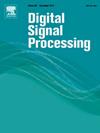A geometry and saliency driven network with adaptive label refinement for weakly supervised medical image segmentation
IF 2.9
3区 工程技术
Q2 ENGINEERING, ELECTRICAL & ELECTRONIC
引用次数: 0
Abstract
Weakly supervised medical image segmentation is promising for its low annotation cost and strong performance, with bounding boxes offering notable advantages over image-level and scribble annotations. However, pseudo-labels generated from bounding boxes often suffer from boundary errors and high uncertainty in transition regions between the target and background, affecting segmentation quality. To overcome these challenges, a geometry and saliency driven weakly supervised segmentation network (GSR-Net) is proposed. The saliency optimization and spatial consistency learning module anchors the centers of segmentation targets, forming the basis for subsequent pseudo-label refinement and enhancing overall consistency. The geometry-guided dynamic feature focusing module uses bounding box geometry to create dynamic boundary weights, refining boundary representations and suppressing background interference. Based on the improved localization and refined boundaries, the dynamic propagation and refinement module iteratively optimizes pseudo labels in uncertain regions, further enhancing segmentation accuracy. Additionally, a random expansion and shrinkage strategy for bounding box annotations is introduced to evaluate the model under varied annotation conditions. Experiments on three representative medical image datasets, namely KiTS23, LiTS, and BraTS2021, demonstrate that GSR-Net significantly outperforms existing weakly supervised methods in segmentation accuracy (Dice) and boundary quality (95HD), exhibiting strong generalization in complex scenarios and under weakly supervised conditions.

用于弱监督医学图像分割的自适应标签细化几何和显著性驱动网络
弱监督医学图像分割具有较低的标注成本和较强的性能,边界框比图像级和潦草标注具有明显的优势。然而,由边界框生成的伪标签往往存在边界误差,目标和背景之间的过渡区域存在很大的不确定性,影响了分割质量。为了克服这些挑战,提出了一种几何和显著性驱动的弱监督分割网络(GSR-Net)。显著性优化和空间一致性学习模块锚定分割目标的中心,为后续的伪标签细化奠定基础,增强整体一致性。几何引导的动态特征聚焦模块使用边界盒几何来创建动态边界权重,细化边界表示并抑制背景干扰。基于改进的定位和细化的边界,动态传播和细化模块迭代优化不确定区域的伪标签,进一步提高分割精度。此外,引入了边界框标注的随机展开和收缩策略,以评估不同标注条件下的模型。在KiTS23、LiTS和BraTS2021三个具有代表性的医学图像数据集上的实验表明,GSR-Net在分割精度(Dice)和边界质量(95HD)方面显著优于现有的弱监督方法,在复杂场景和弱监督条件下表现出较强的泛化能力。
本文章由计算机程序翻译,如有差异,请以英文原文为准。
求助全文
约1分钟内获得全文
求助全文
来源期刊

Digital Signal Processing
工程技术-工程:电子与电气
CiteScore
5.30
自引率
17.20%
发文量
435
审稿时长
66 days
期刊介绍:
Digital Signal Processing: A Review Journal is one of the oldest and most established journals in the field of signal processing yet it aims to be the most innovative. The Journal invites top quality research articles at the frontiers of research in all aspects of signal processing. Our objective is to provide a platform for the publication of ground-breaking research in signal processing with both academic and industrial appeal.
The journal has a special emphasis on statistical signal processing methodology such as Bayesian signal processing, and encourages articles on emerging applications of signal processing such as:
• big data• machine learning• internet of things• information security• systems biology and computational biology,• financial time series analysis,• autonomous vehicles,• quantum computing,• neuromorphic engineering,• human-computer interaction and intelligent user interfaces,• environmental signal processing,• geophysical signal processing including seismic signal processing,• chemioinformatics and bioinformatics,• audio, visual and performance arts,• disaster management and prevention,• renewable energy,
 求助内容:
求助内容: 应助结果提醒方式:
应助结果提醒方式:


